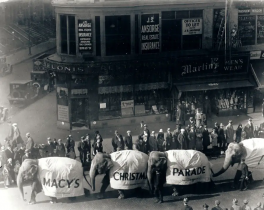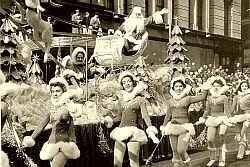Descriptive Narrative: For over 100 Years millions have viewed the Macy’s Thanksgiving Day Parade from the heart of Manhattan. It has evolved and adapted since its inception in 1924 and has become a staple in American tradition.
History:
Every year in America on the fourth Thursday of November, the country celebrates the federal holiday of Thanksgiving. This holiday is full of tradition. Watching football, having a large family gathering, turkey dinners with more appetizers than one should have. One of the more popular traditions that has been occurring for almost 100 years has been the emergence of the annual Macy’s Thanksgiving Day Parade. Started in 1924, the Macy’s Thanksgiving Day Parade has evolved constantly with new technologies and other advancements but has remained a staple in the televisions of American households as well as the streets of New York City.
The first Macy’s Thanksgiving Day Parade happened in 1924 when the Macy’s flagship store located on 34th street in Manhattan and was meant to be a thank you to the employee’s and a spectacle to the children in the city as well as an unveiling of a big Christmas Window to ring in the holiday season. The highlight of the parade was the introduction of Santa Clause at the end of the parade to be crowned the “King of the Kiddies”1. The first parade was the most basic of parades compared to what it has evolved to today. In 1924, the parade, which was given a few days’ notice to the public, consisted of a crowd that was nearly 10,000 people at 34th street between 6th and 7th avenue2. There were no balloons for the first few years, so the parade consisted mainly of floats and participants, most of which were volunteers that worked at Macy’s. There were also other forms of entertainment such as floats that were shaped as the Old Lady who Lived in a Shoe, Little Miss Muffet and Red Riding Hood. Other than the floats, there were bears, elephants, donkeys and bands that were following the parade floats making it appear like a circus on the street but gave entertainment to all the spectators3.

photo found at: https://untappedcities.com/2017/11/23/throw-back-thursday-1924-the-first-macys-thanksgiving-day-parade/
The first major innovation that was brought to the parade since its inception in 1924, was when in 1927, the introduction of the first balloon, Felix the Cat, happened and began the tradition of having balloons in the parade4.

Photo from https://www.pinterest.com/pin/96475616989232665/
The balloons were originally made by the Goodyear tire and rubber plant company and were held by the volunteers with long thin sticks. Balloons became a pivotal part of the future parades to come. The balloons would eventually be filled with helium and were reused for the next years parade. The helium filled balloons were initially let go at the end of the parade route by whoever was holding them and set to the sky. They would eventually fall back down to the ground and if they were returned to Macy’s then the person who would return them would be given a $25 gift card to Macy’s. there would be several additions to the balloon arsenal such as Mickey Mouse, Snoopy, Superman and so many more.
Since 1924, the Parade was an annual tradition and a staple to New York City. It would always be on thanksgiving morning and end with Santa Clause. However, there was a time period in which the parade was not able to be held. Due to the United States involvement in World War 2. Wartime materials were at a high demand and so were all personnel so the parades from 1942-1944 were cancelled as a result of the country focusing most areas of life to be aiding the wartime production efforts 5. Aside from the interruption of the parade due to World War 2, the only other time the balloons were not able to fly in the parade since 1927 was in 1971 where they could not fly due to high winds and rainy conditions.
One of the other biggest innovations to come to the Macy’s Thanksgiving Day Parade was when it was able to reach the masses outside of New York via other media such as the radio and the Television. In 1932 people were able to listen to the Parade on the radio and then 14 years later it became available on the TV after NBC acquired rights to broadcast the parade to those in New York, and then the following year it became broadcasted nationally to all who had a TV 6. This was such a revolutionary concept to be brought to the parade. It took it from the 10,000+ people who had initially been able to view the parade in person in the streets of New York City to have the ability to have the parade accessible to anybody with a TV and helped solidify the Macy’s Thanksgiving Day Parade as a staple to the American Thanksgiving.
Over Time the Macy’s Thanksgiving Day Parade has evolved and transformed from a small parade of 10,000 that was originally meant to unveil a window and to reward Macy’s Employees to becoming a nationwide spectacle where more than 50 million people tune in to watch on the TV, while according to NYCtourist.com, more than 3.5 million people fill the streets of New York every year to watch the parade and several more fill the buildings located on the route to watch from a higher vantage point 7. I was lucky enough to do that in 2017 and escape the cold that millions had endured, and it was cool to see how big the balloons really are and what it takes to run the parade.

The Macy’s Thanksgiving Day Parade has become an essential part of New York City and American tradition. The Macys Thanksgiving Parade features more than 1,500 dancers and cheerleaders, close to 1,000 clowns, almost 30 parade floats, a dozen marching bands, and nearly 8,000 participants in all, as well as several musical acts 8. The parade takes much planning to the point that the planning starts almost right after the parade ends. There is much that goes into it such as getting volunteers to walk and hold the balloons, marching bands and other forms of entertainment for the next years parade. The main takeaway is that the Parade has evolved so much from where it began and is part of New York Tradition and will be for the foreseeable future.
Footnotes.
1: GREET SANTA CLAUS AS ‘KING OF KIDDIES’; Crowds Cheer Him in Parade and Witness Coronation in Macy’s New Store. FLOATS IN THE PAGEANT Visit to City on Thanksgiving Day Marks Unveiling of Big Christmas Window.” New York Times, November 28, 1924.
2: Greet Santa
3: Greet Santa
4: Mettler, Katie; Kirkpatrick, Nick (November 22, 2018). “Macy’s Thanksgiving Day Parade: 91 years of looking up”. Washington Post. Retrieved November 28, 2019.
5: Pleck, Elizabeth. Thanksgiving Has Been Reinvented Many Times, Journal of Social History, Vol. 32, No. 4 (Summer, 1999), pp. 773-789. Oxford University Press.
6: Leopold, Todd. “Macy’s Thanksgiving Parade: 6 Fun Things You May Not Know.” CNN. Cable News Network, November 25, 2015. https://www.cnn.com/travel/article/macys-thanksgiving-day-parade-feat/index.html.
7: Kane, Allison. 2019. “How a Parade Is Made.” Highlights 74 (11): 22–27. http://search.ebscohost.com/login.aspx?direct=true&AuthType=sso&db=fth&AN=138749925&site=eds-live.
8: Bartels, Meghan. “A Whole Lot of Science Goes into Making Sure the Macy’s Thanksgiving Day Parade Goes off without a Hitch.” Newsweek. Newsweek, November 23, 2017. https://www.newsweek.com/science-behind-macys-thanksgiving-day-parade-balloons-helium-plastic-718837.
Bibliography:
Bartels, Meghan. “A Whole Lot of Science Goes into Making Sure the Macy’s Thanksgiving
Day Parade Goes off without a Hitch.” Newsweek. Newsweek, November 23, 2017. https://www.newsweek.com/science-behind-macys-thanksgiving-day-parade-balloons-helium-plastic-718837.
“GREET SANTA CLAUS AS ‘KING OF KIDDIES’; Crowds Cheer Him in Parade and Witness
Coronation in Macy’s New Store. FLOATS IN THE PAGEANT Visit to City on Thanksgiving Day Marks Unveiling of Big Christmas Window.” New York Times, November 28, 1924.
Kane, Allison. 2019. “How a Parade Is Made.” Highlights 74 (11): 22–27.
http://search.ebscohost.com/login.aspx?direct=true&AuthType=sso&db=fth&AN=138749925&site=eds-live.
Leopold, Todd. “Macy’s Thanksgiving Parade: 6 Fun Things You May Not Know.” CNN. Cable
News Network, November 25, 2015. https://www.cnn.com/travel/article/macys-thanksgiving-day-parade-feat/index.html.
Mettler, Katie; Kirkpatrick, Nick (November 22, 2018). “Macy’s Thanksgiving Day Parade: 91
years of looking up”. Washington Post. Retrieved November 28, 2019.
Pleck, Elizabeth. Thanksgiving Has Been Reinvented Many Times, Journal of Social History,
Vol. 32, No. 4 (Summer, 1999), pp. 773-789. Oxford University Press.
